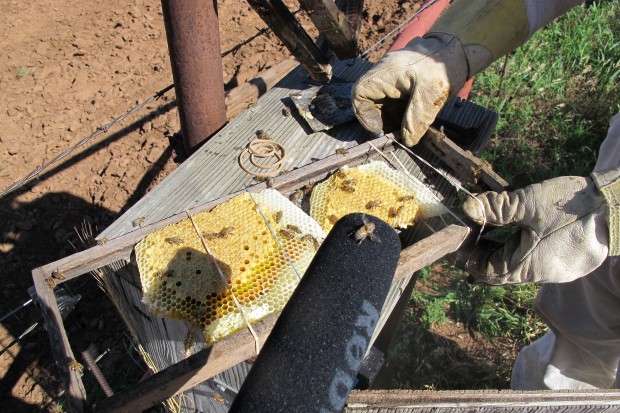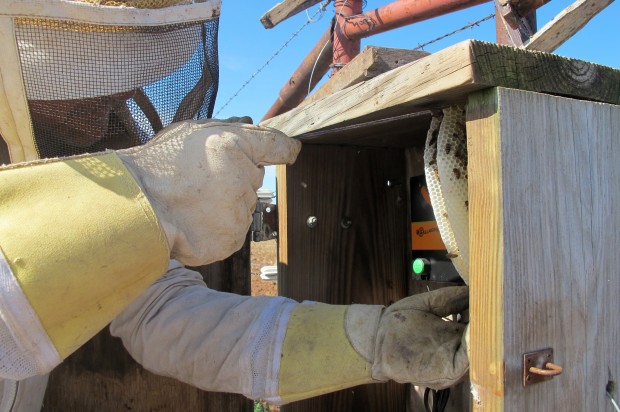
Why Oklahoma Had the Nation’s Highest Percentage Of Bee Deaths Last Year
-
Logan Layden

Logan Layden / StateImpact Oklahoma
Beekeeper Tim McCoy pries a hive of European honeybees out of an electrical box on Ed Crall's property near Weatherford, Okla.
Honeybees are dying at an alarming rate across the country, but no state lost a greater percentage of its bees than Oklahoma over the last year. When it comes to the general public, there’s a lot of mystery around this issue, but the reasons are becoming more clear.
Nathalie Steinhauer from the Bee Informed Partnership at the University of Maryland says the biggest threat to bees comes from varroa mites that came to the U.S. from Asia in the 1990s.
“This is definitely enemy number one for bees around the world,” Steinhauer says. “The second major cause of death would be poor nutrition and habitat loss. Certainly, in areas of the world where we have intense agricultural practices, we have a lot of monocultures and reduction of natural habitat. And then finally pesticide is also one of the top three causes of honeybee colony loss.”
Those are factors that are impacting bees across the U.S., but University of Oklahoma biology professor Ken Hobson says there’s another factor that made the situation worse in the Sooner State.
“Bees are pretty heavily impacted by drought, and we’ve had a five-year drought here in Oklahoma,” Hobson says.
This all seems pretty egregious, right? Man depleting honeybee habitats and exposing them to pesticides, stressing bees to the brink. But there’s something you need to know about these bees. They aren’t native to North America. We brought them here, and they work for us.
“It takes … around 1.5 million hives of bees to pollinate the almond orchards in California. And so, those are not there,” Hobson says. “You have to load them onto trucks, and trucks just arrive from all over the western United States and elsewhere, carrying 1.5 million hives of bees.”
Without beekeepers feeding them and selectively breeding them, honeybee colonies die quickly. So if you see a honeybee, it’s probably part of a managed hive somewhere.

Logan Layden / StateImpact Oklahoma
Weatherford, Okla. Beekeeper Tim McCoy tells StateImpact the commercial beekeeping industry is massive.
“There are people who that’s how they make their living,” McCoy says. “They take their bees from California to Texas, then Georgia, and then to the east coast for apples, over to the Dakotas for clover. They just run them suckers around the country.”
Beekeeping is a lot of work, and expensive, especially when colonies are dying in large numbers and have to be replaced each year. It’s more of an economic problem than an ecological one. If commercial beekeeping gets too expensive, it’s bad news for the country’s food supply. The crops need the bees.
“It’s left us with this Achilles’ heel of a real increasing reliance on the European honeybee,” Hobson says.
But Hobson isn’t too worried about the European honeybee. Mite-resistant bees are being bred, and farmers are starting to think more about bee health. He worries about what the bee deaths tell us about Oklahoma’s ecosystem as a whole.
“You know, bees are kind of a gauge or a monitor — they’re a monitor for the health of the ecosystems,” Hobson says.
Hobson says all the recent rain has been great for the ecosystem, so he expects Oklahoma’s bees to rebound very soon.
